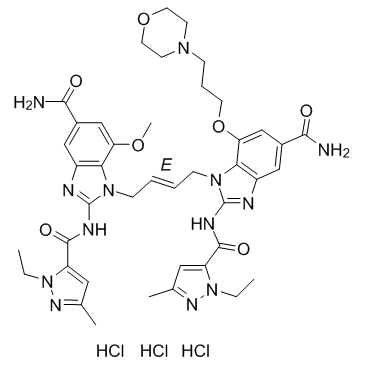diABZI STING agonist-1 trihydrochloride (Synonyms: Diamidobenzimidazole STING Agonist-1, STING Agonist (Compound 3), STING Agonist diABZI) |
| Catalog No.GC35855 |
diABZI STING agonist-1 trihydrochloride es una dosis de STING, a través de receptor desconocido internalizado en las células, mientras guiar la activatión de STNG y dimerización, luego, con la fosforilación de TBK1/IRF3 , que conduce a la respuesta IFN tipo I.
Products are for research use only. Not for human use. We do not sell to patients.

Cas No.: 2138299-34-8
Sample solution is provided at 25 µL, 10mM.
diABZI STING agonist-1 trihydrochloride, as a STING agonist, is internalized into the cytoplasm through unknown receptor and induce the activation and dimerization of STING followed by TBK1/IRF3 phosporylation leading to type I IFN response.[2]
diABZI STING agonist-1 trihydrochloride can activate STING and has an effictively effect in limiting SARS-CoV-2 replication in cells and animals.[1]
In vitro, diABZI dose dependently protected the cells from CPEs with an EC50 value of 3 nM, suggesting the significant anti-HCoV-229E activity comparable to that of Remdesivir (RDV, EC50 = 26 nM). Furthermore, the half maximal cytotoxic concentration value (CC50) of diABZI was greater than 100 μM in MRC-5 cells, indicating that the observed antiviral effects were not related to nonspecific cytotoxicity.[3]
In vitro, treatment with 0.1 μM diABZI-4 in CD14+ human monocytes it shown that diABZI-4 (STING agonist) induced oligomerization of STING, transcription of IFNB1, TNF, CXCL10 and IL6 and the secretion of TNF-α and IFN-βin primary human CD14+ monocytes. In the meanwhile, 0.1 μM of diABZI-4 also inhibits SARS-CoV-2 replication in lung epithelial cells. [1] In vitro efficacy test, treatment with 1 µM DiABZI induced the release of IFNα, IFNβ, CXCL10, IL-6, TNFα, CXCL1, and IL-10 at 16 h. Treatment with 1–10 µM DiABZI induced the expression of IFNβ, IL-1β, and IL-8. In addition, DiABZI at 0.3–1 µM induced the phosphorylation of STING and downstream TBK1 kinase, together with STAT1 phosphorylation, similar to cGAMP.[2]
In vivo experiment it indicated that after endotracheal administration of 0.1–1 µg diABZI, STING overexpression and activation visible by increased STING dimers in immunoblots of lung tissue.
References:
[1].Humphries F, et al. A diamidobenzimidazole STING agonist protects against SARS-CoV-2 infection. Sci Immunol. 2021 May 18;6(59):eabi9002.
[2].Messaoud-Nacer Y, et al. STING agonist diABZI induces PANoptosis and DNA mediated acute respiratory distress syndrome (ARDS). Cell Death Dis. 2022 Mar 25;13(3):269.
[3].Zhu Q, et al. Inhibition of coronavirus infection by a synthetic STING agonist in primary human airway system. Antiviral Res. 2021 Mar;187:105015.
Average Rating: 5 (Based on Reviews and 4 reference(s) in Google Scholar.)
GLPBIO products are for RESEARCH USE ONLY. Please make sure your review or question is research based.
Required fields are marked with *




















